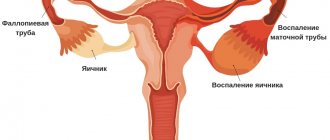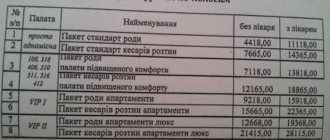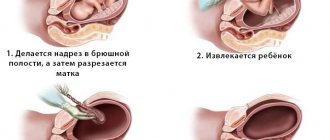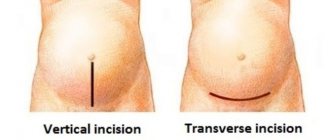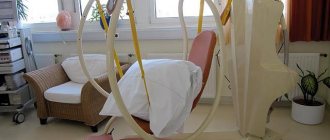It is no secret that almost all women, especially those who are going to give birth to a child for the first time, experience fear of childbirth. Every second patient of mine turns to me with a request to perform surgical delivery, not taking into account the fact that in any operation there are many more disadvantages than positive aspects.
On the one hand, the CS seems like a simple event - you fell asleep under the influence of anesthesia, woke up, and the baby was already nearby. In fact, there are plenty of disadvantages to a caesarean section for the baby and the mother. Therefore, gynecologists almost unanimously insist on natural childbirth if there are no indications for surgery. But not everyone listens to such a reasonable opinion, and many women go to give birth in private clinics, where CS can be done without any indication for a fee. Is this a reasonable decision? Let’s look further, finding out in detail why a caesarean section is dangerous for the mother, and the pros and cons for the child.
Why is a caesarean section dangerous for a baby?
The most important harm lies in the child’s difficulties in adapting to atmospheric pressure. When passing through the birth canal, the baby gradually prepares to meet the world, and his body produces the hormones necessary for this process. What is dangerous about a caesarean section in this matter is that the baby’s blood pressure increases sharply, which can cause a minor cerebral hemorrhage.
Anesthesia also affects the newborn. If epidural anesthesia takes place, the risk is zero, while general anesthesia can penetrate the walls of the placenta, which is why the baby may be lethargic and weak for the first time after birth.
It is easier for a baby born naturally to start breathing, since the amniotic fluid leaves on its own. For Caesar babies, this fluid is sucked out by neonatologists. Therefore, such children are more prone to diseases of the bronchi and lungs.
In a newborn whose mother gave birth through CS, the intestinal microflora populates more slowly, which can cause dysbiosis. But if an emergency caesarean section was performed after the water broke, then the baby receives a certain dose of the necessary bacteria. During a planned, i.e., essentially “sterile” operation, the fetus does not receive such bacteria from the mother. Therefore, in such situations, it is very important for a woman to establish breastfeeding as quickly as possible in order to compensate for their deficiency along with milk.
From the above we can judge whether a caesarean section is dangerous for the baby. But the influence of surgical intervention on the child’s body does not end there.
Recovery period
Recovery after surgery depends on the method of pain relief and the surgical procedure, and includes:
- Recovery from anesthesia. Over the course of 5 days, a woman may experience neurological problems associated with the residual effect of anesthesia. The woman in labor is worried about headache, dizziness, and nausea. On the first day, her condition is monitored in the intensive care unit, and in subsequent days by a midwife.
- Postoperative suture care. In the hospital, the suture is cared for by a nurse or midwife. The wound is washed twice a day with a disinfectant, then lubricated with a solution of brilliant green or fucarcin. After treatment, apply a bandage. Sutures are removed 10 days after surgery.
After being discharged, the young mother must monitor the cleanliness of the wound herself and avoid sudden movements that could cause the suture to diverge.
- Vaginal discharge. After childbirth, bloody discharge (lochia) appears. They will bother you for a month. It is necessary to carefully monitor the nature of the discharge; if blood clots or an unpleasant odor appear, consult a doctor immediately.
- Lactation. In women who have had a caesarean section, milk does not appear immediately; this is due to a lack of the hormone prolactin. In this case, frequent feeding of the baby and herbal teas to improve lactation help.
- Problems in intimate life. Problems of sexual life associated with pain in the postpartum suture, fatigue, and postpartum depression appear in almost 89% of women who have given birth. Sexual life should be resumed 2-3 months after surgery.
How does caesarean section affect the baby?
Before I tell you how the operation affects the baby’s health in the future, let’s briefly consider the effect of a cesarean section on the child’s body.
So, during the QE:
- Babies are typically born premature as surgeries are usually performed at 37 to 37 weeks.
- There is no natural launch of the baby’s internal systems.
- The risk of developing diseases of the bronchopulmonary system in a baby increases by 40%.
- There is no stamp of unity between the newborn and the mother.
- The formation of basic perinatal matrices in the baby is disrupted.
It is important to understand that, if indicated, a cesarean section is less dangerous for a child than a natural birth. Despite the fact that it is much easier for a doctor to perform an operation in half an hour than to go through the entire process of bringing a baby into the world together with the mother, which can drag on even for a day, not a single specialist will resort to surgical intervention unless necessary.
Relative indications for operative delivery
Relative indications are pathologies in which the decision to use a cesarean section is decided by a council of doctors:
- narrow pelvis along with other bases;
- the presence of a scar on the uterus after a previous cesarean section, in the following cases:
- the last operation was less than a year ago, or more than 4 years;
- the pregnant woman has a history of more than 2 surgical deliveries;
- the presence of complications in the healing process of the scar.
- threat of fetal hypoxia;
- breech presentation of the child;
- the gestational age has exceeded 40 weeks;
- first birth when the pregnant woman is over 30 years old:
- aggravating gynecological or obstetric history;
- non-bearing;
- long-term infertility;
- stillbirth
- umbilical cord prolapse.
In obstetric practice, almost all indications for surgery are mixed.
Consequences of caesarean section for a child
So, what could be the consequences and what causes them after a cesarean section for a child? In fact, it is difficult to identify any common inevitable complications. It all depends on how the birth took place, what lifestyle the mother led during pregnancy and, of course, on the professionalism of the doctors.
The most common consequence for the baby is the risk of damage to its skin during the cutting of the uterus. According to statistics, 2% of Caesar babies receive minor injuries during childbirth. But with proper and timely care, the wounds heal quickly without any complications.
Above, I also mentioned possible breathing difficulties for children, their susceptibility to infections, and a deficiency of essential bacteria. In general, cesarean does not have global or serious consequences for the child.
But we cannot fail to mention that such babies are predisposed to the following ailments:
- surges in intracranial pressure;
- visual impairment;
- muscular dystonia;
- adenoiditis;
- hypotonicity/hypertonicity of muscles;
- insomnia, etc.
It is also worth noting that some consequences of cesarean section appear in children even years later. But I will return to this issue in more detail a little later.
Disadvantages and possible complications for mom
- weakness of the body, nausea and dizziness that occur after the cessation of anesthesia;
- the risk of postoperative complications, the sources of which may be infections and chronic diseases;
- large blood loss;
- decreased bowel function, resulting in diarrhea, flatulence, constipation, and bloating;
- long postoperative recovery process;
- suture pain;
- a scar that remains for life;
- discomfort and pain interfering with sexual life for 2-3 months after surgery.
Consequences of caesarean section for the mother
If the percentage of the likelihood of complications occurring in a child during a caesarean section is very low, then for the mother the consequences are almost inevitable. The woman will have to go through a rather difficult recovery period, during which she must limit herself in many ways.
In addition, you may experience:
- Inflammation in the scar area due to the use of low-quality suture material.
- Infections of the uterus and internal genital organs.
- Vein thrombosis.
- Weakening of intestinal functions.
- Bleeding.
- Endometritis.
- Problems with lactation.
Another disadvantage of CS for the mother, although very unlikely, is possible infertility. But sometimes doctors themselves prohibit a second pregnancy if the suture that remains on the woman’s uterus is ineffective and there is a high risk of its divergence.
Absolute indications for caesarean section
The absolute indications for this procedure are pathologies in which vaginal birth is impossible.
These include:
- reduced pelvis due to fractures or other diseases;
- low labor activity or its cessation is an indication for emergency cesarean section;
- placenta previa - located above the cervix, creating obstacles to the birth of a child;
- obstacles to natural childbirth (cancer, uterine fibroids, ovarian tumors);
- threatening or incipient uterine rupture - immediate emergency surgery;
- chronic diseases that appeared before pregnancy, in which childbirth is dangerous to the life and health of the mother:
- vascular diseases;
- heart disease;
- eye diseases, in particular high myopia.
- gestos, especially in severe form;
- bleeding from the genital tract caused by premature placental abruption;
- varicose veins of the vagina, creating the risk of bleeding even with the slightest injury;
- sexual infections;
- acute fetal hypoxia;
- death of a woman in labor while the child is alive.
Does caesarean section affect the development of the child?
Young mothers often ask me how intervention in the birth process affects the child in the future. I can say with one hundred percent certainty that the “Caesareans” are no different from other children. There is only a psychological aspect, which, however, has not been fully confirmed.
According to Western psychologists, a child after a cesarean section:
- afraid of change;
- touchy;
- hot-tempered;
- absent-minded;
- anxious;
- weak-willed;
- hyperactive.
It is also believed that it is difficult for “Caesarians” to plan and control anything on their own, they often experience attention deficit, and are not inclined to achieve high results in what they love. But, I repeat, all this is just speculation, not confirmed by anything. Based on many years of experience, as well as the point of view of most of my colleagues, I am ready to assert that cesarean does not affect the development of the child.
Doctors' opinion
The topic of the dangers of CS for a child is one of the most discussed in medical forums. Here is what a gynecologist of the highest category, a teacher at the Department of Obstetrics and Gynecology, Elena Mishchenko, says about this: “Naturally, surgical childbirth has its own characteristics and carries certain consequences. A baby born in this way is more difficult to adapt to the environment, all systems of his body function more slowly, problems with breathing, peristalsis, etc. may arise. But if the mother led a healthy lifestyle during pregnancy and followed all the instructions of the attending physician, the risk of The possibility that the operation will somehow affect the fetus is minimal. Therefore, everything is in the hands of the woman, and especially the condition of her unborn child.”
What happens on the operating table?
First of all, a catheter will be inserted into the bladder to allow urine to pass freely. Your arms and legs will be fixed on the operating table and anesthesia will be administered. There are two types of anesthesia: spinal anesthesia (epidural) or general anesthesia. With an epidural, you are fully aware of what is happening, but the lower part of your body is devoid of sensation. Nowadays, spinal anesthesia is most often used. General anesthesia is more dangerous for the physical health of both mother and baby, and being conscious during the operation is simply psychologically uncomfortable for the mother. It’s really scary when you realize that your stomach and uterus are being cut open, you hear all the sounds and conversations of the doctors. But for the mother, the main thing is that it is safer for the baby, which is why epidural anesthesia is more popular.
After anesthesia, your stomach will be lubricated with an antiseptic, and a screen will be installed at the level of your chest so that you cannot see the progress of the operation. And... with God!
Interesting: The first “swallows”, or harbingers of childbirth
